Platform semi trailers

They are usually available with two or three axles. These trailers are often equipped with invasions, container holders, stanchions. These trailers are mainly used for oversized transport, containers, agricultural and construction machinery, and all sorts of structures. A platform semi-trailer is not an extendible semi-trailer.These trailers differ in the height of the deck ( h = 1.00 - 1.35m )
Loading capacity: 18-36 tonnes depending on the number of axles and the coupled tractor unit
Telle-mega semi trailers
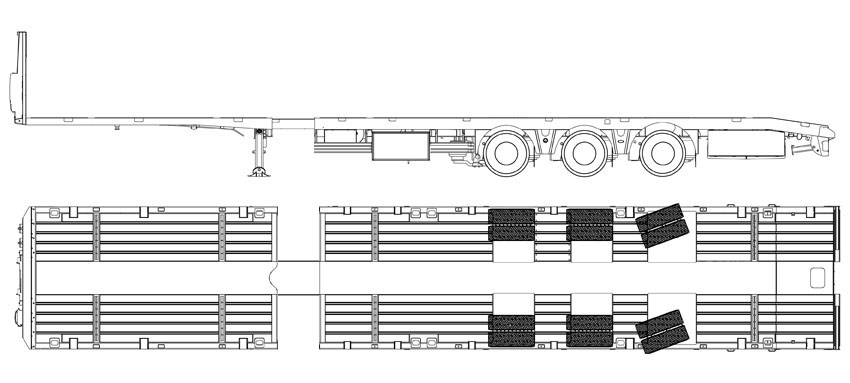
A low-floor, flatbed "single-deck" semi-trailer, usually three-axle, single or double-stretch. Commonly referred to as a "telle-mega". This semi-trailer is structurally very similar to the 13.60 platform, but is a stretched semi-trailer with a reinforced construction.
Depending on manufacturer and model, these trailers have "forced" or hydraulically controlled axles. As a standard these trailers are equipped with: invasions, stanchions, twist-locks (container locks), extensions.
Telle-mega" type semi-trailers are the most universal means of transport, as their simple and lightweight construction allows us to load metal sheets / steel in steel mills. In the case of single load semi-trailers, we can load elements up to 20-22 metres long, and in the case of double load semi-trailers up to 30 metres long.
The backbone of the semi-trailer is often fitted with sliding tables, which allows the semi-trailer to be extended to support the goods at any location (please note that their load capacity is limited). The main application of "telle-mega" semi-trailers is the transport of: construction and industrial machinery, steel and concrete structures, tanks, containers, steel. Loading capacity: 24 - 34 tonnes depending on semi-trailer manufacturer, model and tractor unit used. Loading height: 100 - 115 cm depending on the model, manufacturer and the truck tractor used.
Telle-sattel trailers
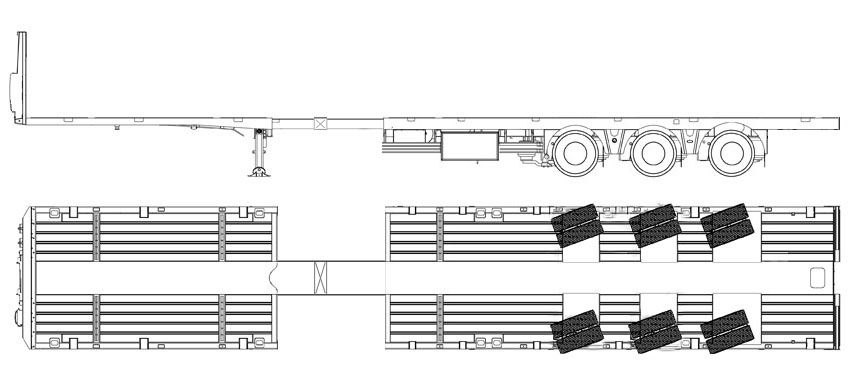
A specialist type of semi-trailer used mainly for the transport of long components such as wind turbine propellers, pipes, structures, bridge elements, etc. These semi-trailers come in 2,3,4,5,6 axle versions, with the longest versions extending up to 80m. These trailers, depending on manufacturer and model, have hydraulic axles (in newer and more expensive models hydraulic swing axles are used), the whole system is often based on so-called turntables. Standard equipment of these trailers includes: stanchions, twist-locks (container locks), extensions, etc.
On the spine of the semi-trailer there are often mounted so called sliding tables, which allow us to support the cargo in any place (note that the load capacity is limited and the number of tables varies).
Loading capacity: xxxxxxxxxx tonnes depending on trailer manufacturer, model and tractor unit used. Loading height: 100 - 115cm depending on the semi-trailer model, manufacturer and the tractor unit used.
Flatbed semitrailer „Schraglader”

Semi-trailers whose main advantage is the ability to transport goods at an angle, which allows us to reduce the width. This often means that we do not need permits, pilot vehicles, or simply a semi-trailer of this type will allow us to transport goods with a much smaller width than in the case of full-size transport with a classic flat semi-trailer.The floor of the semi-trailer, or part of it, is raised to the angle required by us using hydraulic cylinders.
Schraglader semi-trailers are available in 2,3,4 axle versions, based on the basis of semi-trailers: platform, semi or tiefbett. Their loading capacity depends on the construction, number of axles, manufacturer and ranges from 18 to 38 tonnes. They are used to transport abnormal loads, mainly flat structures such as walls, rings, plates, bottoms, etc
Jumbo trailers

Low-floor semi-trailer available in two-, three- and four-axle versions, both open and closed. These trailers are often equipped with invasions. Sometimes jumbo semi-trailers are available in extended versions and with raised tarpaulins. Double-deck semi-trailers. The main application is volume transport (in the case of closed semi-trailers) and oversize transport. The main advantage of these trailers is low weight and relatively high strength. Closed, extended semi-trailers often have the ability to raise the roof of the semi-trailer, which allows us to transport bulky goods under the cover of the semi-trailer (mainly industrial electronics)
Payload: 20 - 42 tonnes depending on the number of axles and the truck tractor used. Loading deck height ( lower deck from 80 to 95cm ; upper deck from 135 to 150cm )
Low loader 4 axle „ semi”

Low-floor semi-trailer with three or four axles, commonly known as a "semi-trailer".
A double-deck semi-trailer. Upper deck, so-called "balcony" Depending on the design and manufacturer, the upper deck, often referred to as the "swan's neck" measures 2.50-4.00m, as long as this area is not occupied by additional equipment such as belts, chains, wheels, tarpaulins (for covering loads), raiders, etc. It is also used as a loading surface. In many European countries, the so-called "upper deck" is not intended for transporting cargo - this is regulated by the regulations of the relevant EU country.
The lower deck measures 9.00 - 11.0 m, depending on the model
Semi-trailers are often equipped with: stanchions, extensions (aluminium inserts, allowing transport of goods with wider spacing) and raids. Ridges in this type of semi-trailers are hydraulic or aluminium raids mounted on the lip of the semi-trailer. Hydraulic raids are mainly longer (up to 4.0m), and their main advantage is the speed of disassembling and the possibility of loading the majority of machines and vehicles. Ridges are shorter and usually have a capacity of 250 cm and 24-38 tonnes depending on the model. The main advantage of an impostable dock leveller is the possibility of loading it onto a semi-trailer with the so-called overhang.
"Semi-trailers" can also be equipped with troughs. These are holes in the structure of the semi-trailer, which allow the entry of the machine, vehicle by wheels, so that the transported machine can be immersed in the structure of the semi-trailer from several to several dozen centimeters.
"Semi-trailers" are semi-trailers with one, two or three extensions of the load deck height from 760mm to 100mm (depending on the model and the truck tractor used, the number of the semi-trailer backbones). The so-called sliding tables are often mounted on the backbone of the semi-trailer, which allows us to support the goods at any location after extending the semi-trailer. These trailers extend to a maximum of 36.0 metres.
The main application of semi-trailers is the transport of construction and industrial machinery, steel and concrete structures and tanks. Payload: 30 - 48 tonnes depending on trailer manufacturer, model and tractor unit used. Type of axles used: Forced / hydraulic. Loading deck height: (lower deck from 76 to 100cm ; upper deck from 125 to 150cm )
Low loader 6 axle „ semi”

A low-floor semi-trailer with three or six axles, commonly known as a "semi-trailer". A double-deck semi-trailer. Upper deck, so-called "balcony" Depending on the design and manufacturer, the upper deck, often referred to as the "swan's neck" measures 2.50-4.00m, as long as this area is not occupied by additional equipment such as belts, chains, wheels, tarpaulins (for covering loads), raiders, etc. It is also used as a loading surface. In many European countries, the so-called "upper deck" is not intended for transporting cargo - this is regulated by the regulations of the relevant EU country. The lower deck measures 10.0 - 13.0 m, depending on the model
"Semi-trailers "are often equipped with: stanchions, extensions (aluminium inserts, allowing transport of goods with wider spacing) and raids. Ridges in this type of semi-trailers are hydraulic or aluminium raids mounted on the lip of the semi-trailer. Hydraulic raids are mainly longer (up to 4.0m), and their main advantage is the speed of disassembling and the possibility of loading the majority of machines and vehicles. Depending on the model, the add-on racks are shorter and usually have a load capacity of approx. 250 cm and 50 tonnes. The main advantage of semi-trailers is that they can be loaded onto a semi-trailer with an overhang.
"Semi-trailers "can also be fitted with troughs. These are holes in the structure of the semi-trailer that allow the wheels of the machine to be driven in, so that the transported machine can be immersed in the structure of the semi-trailer from several to several dozen centimetres.
"Semi-trailers" are extendable semi-trailers with a single, double or triple extension of the load deck height from 760mm to 100mm (depending on the model and the tractor unit used, the number of semi-trailer backbones). The so-called sliding tables are often mounted on the backbone of the semi-trailer, which allows us to support the goods at any location after extending the semi-trailer. These trailers extend to a maximum of 38.0 metres.
The main application of semi-trailers is the transport of construction and industrial machinery, steel and concrete structures and tanks.
These "semi-trailers" can be optionally equipped with systems for transporting wagons, trams, locomotives.
Loading capacity: 60 - 80 tonnes depending on semi-trailer manufacturer, model and tractor unit used."Semi-trailers" of this type are often equipped with a detachable swan neck. Axles in such trailers are only found in hydraulic versions. Loading deck height:( lower deck from 90 to 110cm ; upper deck from 130 to 150cm )
Modular semitrailers

Definitely the most expensive type of transport, among all semi-trailers intendedfor heavy, bulky transport. These vehicles are characterised by practically endless possibilities. These are widened semi-trailers, stretched, with various loading heights. These semi-trailers can be configured in any way you like, creating a train of 20-40-100 axles (defacto endless) or inserting an appropriate transport deck between individual modules (e.g. for transporting pipes or tanks). Modular semi-trailers are coupled to multi-axle tractors. Often, because of the weight, they are coupled simultaneously to two tractors, one at the front and one at the rear, or to ballast tractors. In recent years, modular semi-trailers, self-propelled semi-trailers ...When it comes to maximum transport capacity, one could say that nothing limits us except the road conditions. There are known worldwide transports with a weight of 600 tons!
Lift Adapter

Semi-trailers used for abnormal heavy transport, mainly for the transport of wind power plant components such as pipe sections and propellers.
Container chassis trailers

As the name suggests, these trailers are mainly used to transport sea containers of various dimensions. They are available in the following versions: 2,3,4 and 5 axle. These semi-trailers can be divided into typical container semi-trailers (chassis) and universal platform semi-trailers 13.60m with container handles, while the former are characterised by a much lower weight (from 3,6 to.) Another division concerns rigid container semi-trailers (non-stretchable) and extendable container semi-trailers both at the front, inside and at the back.
The main and principal advantage of container chassis / semi-trailers is the use of container locks, commonly called "twist-locks", which allow adequate protection of containers on the trailer. "Semi-trailers" / container chassis have the ability to transport containers: 20`, 30`, 40`, 45`. Loading capacity of semi-trailers depends on the number of axles and the tractor unit and ranges from 18 to 40 tonnes. Loading height from 110cm.
Wideable tarpauline semitrailers
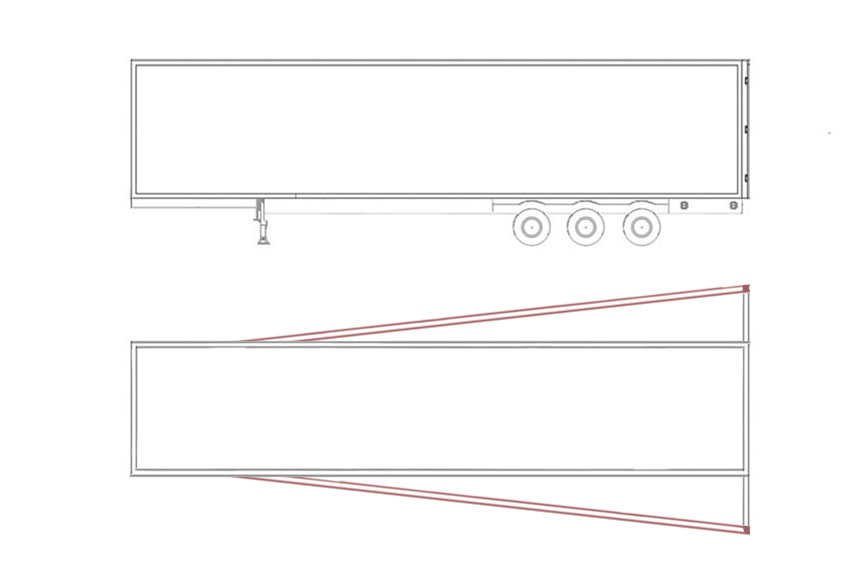
These semi-trailers are based on tarpaulin / curtain 13.60m, except that their design allows you to raise the roof to a total height of 4,50m (including the trailer) and allows you to extend the side walls to 3,50m, which allows us to transport cargo with transport parameters up to: 13,50x3,50x3,30m [ length x width x height ] .This type of semi-trailers allows us to transport bulky loads that are sensitive to changes in weather conditions. They are mainly used to transport devices, industrial machines equipped with electronics.
Loading in the case of these trailers may take place from the top, rear or both sides. Loading capacity: 22-25 tonnes depending on model, manufacturer and coupled tractor unit.
Low bed semitrailers „tiefbett 3 axle”

A low-floor semi-trailer with three axles, in both open and closed versions (as a closed low-floor tiefbett, often widened and raised). A type of three-deck semi-trailer where the upper deck, commonly called the "swan-neck", is used mainly for storing trailer equipment such as belts, chains, sometimes rails, wheels, etc. The middle deck is the actual loading area. The third deck is often referred to as the "bogie" by drivers and forwarders. This is the area above the axles of the trailer. In many EU countries, this area is not considered a transport area.
Older models were available as non-stretchable trailers. Newer models, in addition to being extendable, have the possibility of extending the floor up to 3.20m.
The deck height depends on the model and manufacturer and is 0.30 - 0.50m. The same applies to the loading area, which is 7.00 - 14.00m (including the extension).
Older types of semi-trailers were equipped with raiders, often hydraulic. A hydraulic "swan neck" is standard on newer models. After removing the front element of the semi-trailer, the driver can load any goods entering from the front. This is an ingenious solution, which allows trouble-free entry of, for example, forklifts, generally equipment, machinery, low-slung vehicles with low ground clearance.
Semi-trailers of the "tiefbett" type are available with a full floor (some models have the possibility of pulling out the middle part of the floor), where the main structure of the semi-trailer, or more precisely its lower deck, consists of two spinal columns on both sides of the body. A second type of semi-trailer is the so-called "harvester semi-trailer". ("Baggerbrucke" in German). In this type of semi-trailer, the main structure of the semi-trailer, namely the lower deck, is located in the middle of the semi-trailer (these are also extendable semi-trailers), so that equipment such as loaders, excavators, harvesters, etc., can rest on the chassis on the spine of the semi-trailer. This solution often allows us to drop a few centimetres in height and, above all, allows express loading. Unfortunately, this type of trailer is not suitable for most loads.
There are also models that have a full floor, and their central part (the so-called "spine") is suspended at a height of 0.45 - 0.50m, and the rest of the deck is lowered by 15-20cm, which allows the entry of machinery / equipment on the lower deck of the trailer. Payload: 28-36 tonnes depending on model, manufacturer and coupled tractor unit. Semi-trailers of this type are optionally available with a so-called "bogie-dolly" with one or two axles. This solution allows us to increase the load capacity and spread the pressure
Low bed semitrailers „tiefbett 4 axle”

Low-floor semi-trailer with four axles, both open and closed versions (as low-floor closed tiefbett, often widened and raised). It is a type of three-deck semi-trailer where the upper deck, commonly called the "swan-neck", is used mainly for storing trailer equipment such as belts, chains, sometimes rails, wheels, etc. The middle deck is the actual loading area. The third deck is often referred to as the "bogie" by drivers and forwarders. This is the area above the axles of the trailer. In many EU countries, this area is not considered a transport area.
Older models were available as non-stretchable trailers. Newer models, in addition to being extendable, have the possibility of extending the floor up to 3.20m.
The deck height depends on the model and manufacturer and is 0.30 - 0.50m. The same applies to the loading area, which is 7.00 - 14.00m (including the extension). Older types of semi-trailers were equipped with raiders, often hydraulic. A hydraulic "swan neck" is standard on newer models. After removing the front element of the semi-trailer, the driver can load any goods entering from the front. This is an ingenious solution, which allows trouble-free entry of, for example, forklifts, generally equipment, machinery, low-slung vehicles with low ground clearance.
Semi-trailers of the "tiefbett" type are available with a full floor (some models have the possibility of pulling out the middle part of the floor), where the main structure of the semi-trailer, or more precisely its lower deck, consists of two spinal columns on both sides of the body. A second type of semi-trailer is the so-called "harvester semi-trailer". ("Baggerbrucke" in German). In this type of semi-trailer, the main structure of the semi-trailer, namely the lower deck, is located in the middle of the semi-trailer (these are also extendable semi-trailers), so that equipment such as loaders, excavators, harvesters, etc., can rest on the chassis on the spine of the semi-trailer. This solution often allows us to drop a few centimetres in height and, above all, allows express loading. Unfortunately, this type of trailer is not suitable for most loads.
There are also models that have a full floor, and their central part (the so-called "spine") is suspended at a height of 0.45 - 0.50m, and the rest of the deck is lowered by 15-20cm, which allows the entry of machinery / equipment on the lower deck of the trailer.
Tiefbett semi-trailers are available as single- or double-stretch trailers. Some semi-trailers have the option of installing a so-called "insert", which is technologically an additional part of the semi-trailer, allowing us to extend the deck of the semi-trailer up to 30 metres. Loading capacity: 34 to 42 tonnes depending on model, manufacturer and coupled tractor unit.
Most new trailers of this type have the option of changing the floor, i.e. the actual transport surface of the trailer. Tiefbett semi-trailers of this type are rarely found as single units. They are usually part of a "vario" trailer consisting of decks with different functionality and axle configurations. They have the possibility of adding "dolly" bogies (1,2,3,4 axles), as well as adding an additional axle to the so-called parent unit. Thus we can speak of a modular semi-trailer.Semi-trailers of this type are optionally available with a so-called 'dolly-truck', with one, two or three axles. This solution allows us to increase the payload of the set and spread the pressure.
"Baggerbrucke" trailers ( kind of tiefbett trailer )

Semi-trailers available in 2,3,4,5,6 axle configuration, often coupled with a so-called "dolly" carriage Used mainly for heavy, bulky transport.
They are characterised by a single, central "spine" Semi-trailers used mainly to transport combine harvesters, large demolition excavators, tanks, piling rigs, drilling rigs. The transported vehicles are supported on the chassis, and the wheels or tracks hang on the sides of the main semi-trailer structure.
These trailers also come in extendable versions - the length depends on the model and manufacturer.
Loading capacity 20-80 tonnes depending on the number of semi-trailer axles and tractor unit coupled
"Kesselbrucke" trailers ( kind of tiefbett trailer )
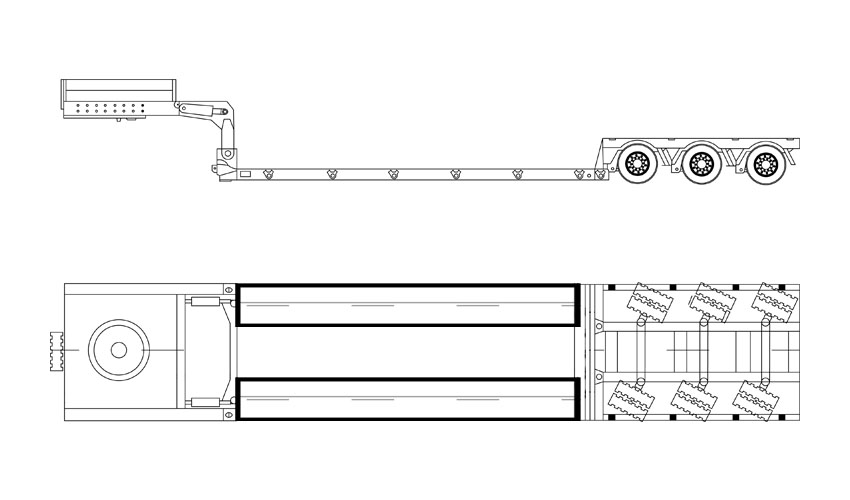
They are characterised by two "spines" on either side of the trailer. These trailers are mainly used to transport bulky cargo such as tanks, pipes, sections of wind towers, silos and various steel structures. These trailers are available in 2,3,4,5,6 axle versions. They have one, two or three extensions.
Loading capacity: 20 to 85 tonnes depending on the configuration of the set and the tractor.
Tiefbett 5 axles / Vario / Modular low bed trailers
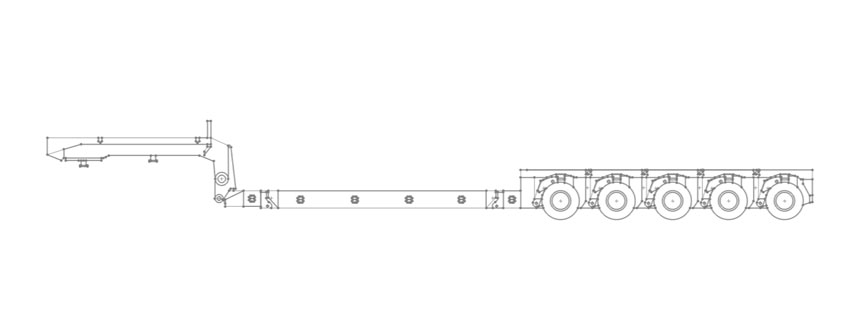
Low-floor semi-trailer available in five-axle open version. A type of three-deck semi-trailer where the upper deck, commonly called the "swan's neck", is used mainly for storing semi-trailer accessories such as belts, chains, sometimes rails, wheels, etc. The middle deck is the actual loading area. The third deck is often referred to as the "bogie" by drivers and forwarders. This is the area above the axles of the trailer. In many EU countries, this area is not considered a transport area. Older models were available as non-stretchable trailers. Newer models, in addition to being extendable, have the possibility of extending the floor up to 3.20m. The deck height depends on the model and manufacturer and ranges from 0.30 to 0.60m. Similarly, the loading area is 7.00 - 14.00m (including the extension).
A detachable hydraulic "swan neck" is standard on newer models. After removing the front element of the semi-trailer, the driver can load any goods entering from the front. This is an ingenious solution, which allows trouble-free entry of e.g. forklifts, generally equipment, machinery, low-slung vehicles with low ground clearance.
Semi-trailers of the "tiefbett" type are available with a full floor (some models have the possibility of pulling out the middle part of the floor), where the main structure of the semi-trailer, or more precisely its lower deck, consists of two spinal columns on both sides of the body. A second type of semi-trailer is the so-called "harvester semi-trailer". ("Baggerbrucke" in German). In this type of semi-trailer, the main structure of the semi-trailer, namely the lower deck, is located in the middle of the semi-trailer (these are also extendable semi-trailers), so that equipment such as loaders, excavators, harvesters, etc., can rest on the chassis on the spine of the semi-trailer. This solution often allows us to drop a few centimetres in height and, above all, allows express loading. Unfortunately, this type of trailer is not suitable for most loads.
Five-axle trailers are also known as "Kesselbrucke" trailers.
There are also models, which have a full floor, and their middle part (the so-called "spine") is suspended at a height of about 0.45 - 0.50m, and the rest of the deck is lowered by 15-20cm, which allows the entry of machinery / equipment on the lower deck of the trailer. Semi-trailers of the "tiefbett 5 axle" type are usually available as single or double extensions. Some trailers have the option of installing a so-called "insert", which is technologically an additional part of the trailer that allows us to extend the trailer deck. Loading capacity: 40 to 50 tonnes depending on model, manufacturer and coupled tractor unit.
Semi-trailers of this type are optionally available with a so-called "bogie-dolly" with one, two or three axles. This solution allows us to increase the payload of the set and spread the pressure. Most new semi-trailers of this type have the possibility of replacing the floor, which is the proper transport surface of the semi-trailer. Tiefbett semi-trailers of this type rarely come as single units. They are usually part of a "vario" trailer consisting of decks with different functionality and axle configurations. They have the possibility of adding "dolly" bogies (1,2,3,4 axles), as well as adding an additional axle to the so-called parent unit. Thus we can speak of a modular trailer.
TO BE CONTINUED....
COPYRIGHT BY Peter :)
Dokumenty:Certyfikat kompetencji zawodowych
Udaje o Subiektach DPH ( VAT )
Výpis z ŽR
Insurance
Our TimoCom number: 429909
